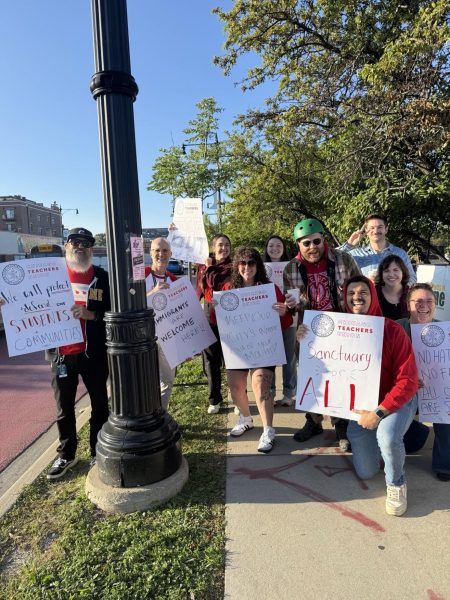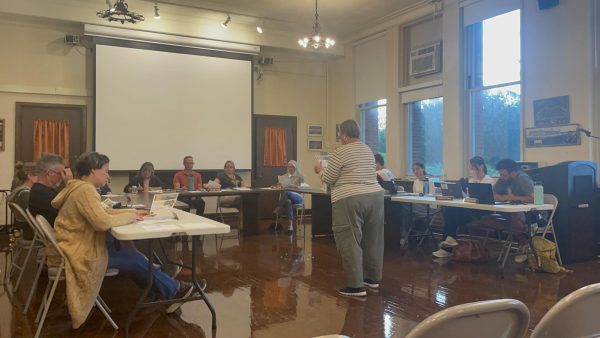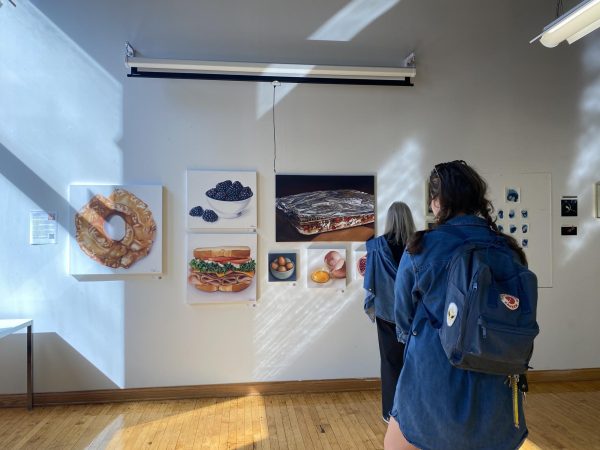STEM Fair: more than just a presentation
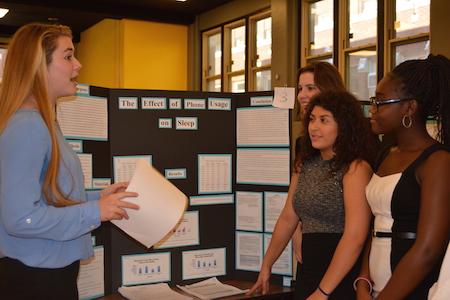
Kayla Dutton, Div. 977 presenting her science fair project to fellow students.
The night before, students are rushing to finish their black trifold boards. The next morning, they shuffle into the lunchroom, dressed professionally in suits and business skirts. For many students, Dec. 13 may seem like a regular Tuesday. For those competing in the Winter STEM Fair, it is the day they get to display the months of hard work spent on their projects.
According to STEM Fair coordinator and Alpha Chemistry teacher, Mrs. Lucy Young, 52 students participated in this year’s fair. Lane hosts the largest STEM Fair on both a district and state level, according to the STEM website.

Daniel Puczko, Div. 878, won first place with a project on the effect of glucose concentration on microbial fuel cells. Robert Szymczyk, Div. 973, came in second with his project on the effect of water pollution on mosquitoes. In third place, was Isabella Altenbach, Div. 883, with her project on the effect of frequency on wireless electricity.
The top ten projects will move on from the school-level Science fair compete in the Regional Science Fair, hosted at Northeastern Illinois University. Students then have the opportunity to compete to advance to city, state, and International Science Fair.
Previous students who have advanced to International received awards, scholarships, published papers and patents for their research, according to Mr. Nathan Nordlund, an Alpha English teacher.
First place winner Puczko advanced to Internationals last year. Puczko, who was a part of the Academic Center, began participating in the science fair in eighth grade and had continued to compete every year after.
“My favorite part is the competition,” Puczko said. “I enjoy speaking to a large group of people who I know can understand.”
For other students, participating in the science fair gives them the opportunity to further develop or discover a love for science.
Altenbach, the third place winner, has competed in science since the eighth grade. Altenbach said that science fair not only makes her feel “empowered,” but that it also shows her that science is not a field only for boys.
“It opens your eyes to new scientific fields, and the possible jobs that you could go into,” Altenbach said. “They’re trying to make more girls pursue a career in science, and I think that it’s a great opportunity.”
Others view the science fair as a learning opportunity, teaching them skills outside of science. Stefan Borjan, Div. 875, said that the skills he learned in science fair are applicable in any situation.
“You become very adaptable because interview skills are important, and you have to be able to quickly summarize your project and answer any questions with accuracy to do well,” Borjan said. “You also need the work ethic in order to be able to finish everything.”
Borjan also credited competing in the science fair as the reason he changed his career path. Competing in the STEM fair requires completing an intensive research paper on the project chosen, according to Borjan.
“The thing that science fair did for me, was that it made me realize that research is not what I want to do,” Borjan said. “I don’t want to be writing essays. Instead I prefer to do engineering. But without science fair, I’m not sure that I would’ve really realized that.”
To help keep students on track with both their paper and project, teachers provide outside support.
Nordlund, an Alpha STEM Literature teacher, assists in running the science fair. He compares the student’s choosing a topic for science fair to a marriage, where they need to love what they have chosen, or else they will be miserable.
“It’s a very brutal process,” Nordlund said. “But it’s definitely worthwhile.”
According to Mrs. Lucy Young, the Alpha STEM Coordinator and Alpha Chemistry teacher, each student has a teacher sponsor, while she and Nordlund provide help with deadlines.
Young said that her favorite part of the fairs is the “learning experience,” which reminded her of her experience competing in science fairs.
“Just in essence the nature of exploring, the nature of finding something that you didn’t know before,” Young said. “In class you’re in a certain curriculum and you have to follow a specific pattern. The STEM fair allows you to go beyond that, and lets you try new things. To make a connection that’s meaningful to you.”
This is also Valerie Villanueva’s favorite part of competing.
“People don’t understand that after science fair, you actually learn something,” Villanueva said. “There’s lots of new discoveries and you get a better understanding from your science fair experiment afterwards.”
The integrated nature of the science fair, as well as the ownership that students take of their project is admired by all STEM teachers.
“People shouldn’t be intimidated by STEM Fair,” Young said. “It’s a discovery.”
Your donations directly fund the Lane Tech student journalism program—covering essential costs like website hosting and technology not supported by our school or district. Your generosity empowers our student reporters to investigate, write, and publish impactful stories that matter to our school community.
This website is more than a publishing platform—it's an archive, a research tool, and a source of truth. Every dollar helps us preserve and grow this resource so future students can learn from and build on the work being done today.
Thank you for supporting the next generation of journalists at Lane Tech College Prep!
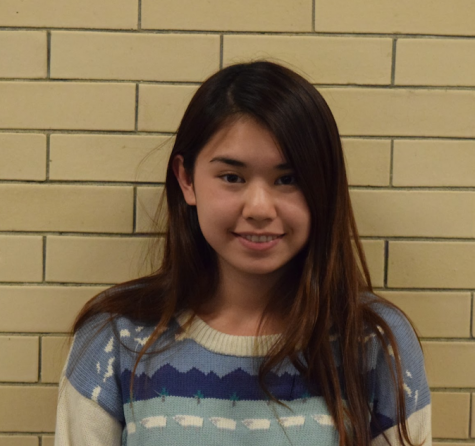
Brianna is Vietnamese, and was born and raised in Chicago. Her favorite past time activity is napping and eating. When she’s not doing either, she likes...

